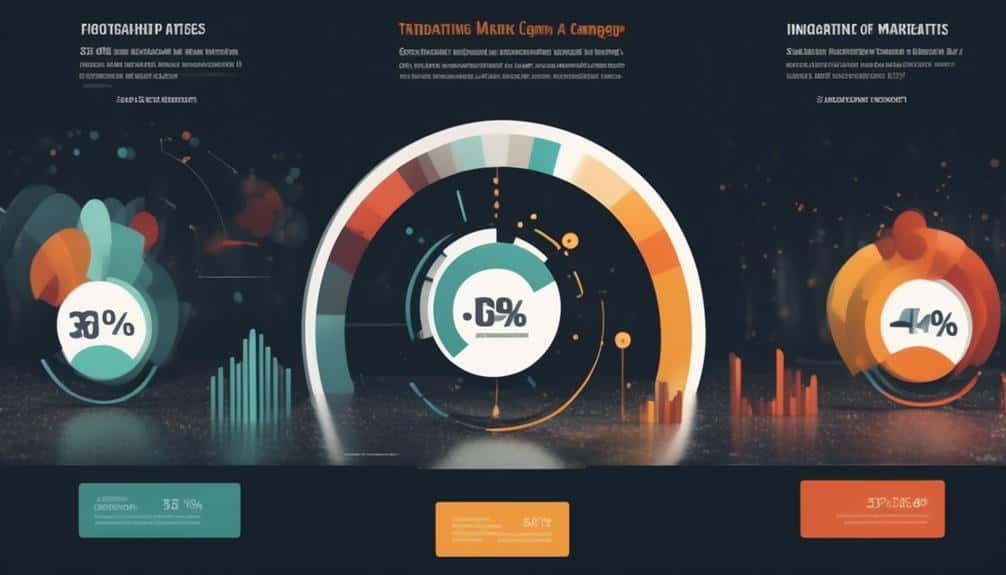Infographics for Impact: Simplifying Complex Information With Visuals
Have you ever pondered how a single image can unravel intricate data with ease, making it not only comprehensible but also memorable?
Infographics possess the power to distill complex information into visually appealing snippets that leave a lasting impact on viewers.
From simplifying statistical figures to engaging audiences effectively, infographics serve as potent tools in a world inundated with data.
Curious to uncover the secrets behind how infographics can revolutionize the way information is conveyed?
Key Takeaways
- Infographics effectively simplify complex information
- Visual design techniques such as simplicity and hierarchy enhance impact
- Data visualization strategies like color psychology aid message conveyance
- Design principles ensure effective communication and engagement
Importance of Infographics

When used effectively, infographics have the power to convey complex information in a visually appealing and easily understandable manner. Visual communication through infographics is a powerful tool in today's fast-paced world where attention spans are short. Information design is crucial for translating data into a format that isn't only attractive but also easily digestible.
By utilizing infographics, you can present data in a way that captivates your audience and makes information more memorable. The strategic use of colors, icons, and layouts can enhance the overall message you want to convey. Infographics offer a dynamic way to engage with your audience, making even the most intricate data more accessible.
In a world inundated with information, infographics cut through the noise and deliver key messages effectively. They provide a visually stimulating experience that appeals to the modern audience's preference for quick and engaging content. Harness the power of visual communication and information design through infographics to make a lasting impact.
Visual Storytelling Techniques
Employ visual storytelling techniques to captivate your audience and convey compelling narratives that leave a lasting impression. By mastering the art of visual narrative and graphic storytelling, you can create impactful infographics that resonate with your viewers on a deeper level.
Here are three key techniques to enhance your visual storytelling skills:
- Embrace Simplicity: Simplify your visual elements to focus on the core message. Use clean lines, minimalistic design, and a cohesive color palette to guide your audience's eyes smoothly through the narrative without distractions.
- Utilize Visual Hierarchy: Arrange elements strategically to highlight the most critical information first. Employ size, color, contrast, and placement to direct attention and create a flow that leads the viewer through the story in a logical sequence.
- Inject Emotion: Infuse your visuals with emotion to make a genuine connection. Use expressive imagery, relatable characters, and engaging metaphors to evoke feelings and create a memorable experience for your audience.
Data Visualization Strategies

To effectively convey complex data insights, focus on utilizing visually engaging techniques that simplify information and enhance comprehension for your audience. When creating data visualizations, consider incorporating interactive features that allow your audience to explore the data further. Interactive elements like hover-over effects or clickable components can provide a more engaging experience and enable users to delve deeper into the information presented.
Additionally, leveraging color psychology can significantly impact how your audience interprets the data. Different colors evoke various emotions and associations, so strategically selecting colors can help convey the intended message more effectively. For example, using warm colors like red and orange can signify urgency or importance, while cool colors like blue and green can evoke calmness and trust.
Consider the following table showcasing how interactive features and color psychology can enhance your data visualizations:
| Interactive Features | Color Psychology |
|---|---|
| Hover-over effects | Warm colors |
| Clickable elements | Cool colors |
Design Principles for Impact
Enhance the impact of your data visualizations by incorporating design principles that captivate and inform your audience effectively. When designing infographics, consider the following key elements to ensure your visuals are engaging and easy to comprehend:
- Color Psychology: Utilize colors strategically to evoke emotions and convey messages. Consider the psychological effects of different colors on your audience. For example, use warm tones like red and orange to grab attention or cool tones like blue and green to promote a sense of calmness and trust.
- Information Hierarchy: Establish a clear hierarchy in your design to guide the viewer's attention. Use varying font sizes, colors, and spacing to differentiate between headline, subheadings, and body text. This ensures that important information stands out and is easily digestible.
- Visual Consistency: Maintain a consistent visual style throughout your infographic to create coherence and unity. Use a cohesive color palette, typography, and iconography to tie the different elements together seamlessly, enhancing the overall look and feel of your design.
Simplifying Statistical Data

When simplifying statistical data, remember to visualize data trends for a clear and impactful presentation.
Make statistical insights visual, allowing viewers to grasp complex information at a glance.
Enhance comprehension by presenting data in a visually engaging manner.
Visualizing Data Trends
Transforming complex statistical data into visually compelling infographics can greatly enhance the impact of your message. Visualizing data trends allows for a quicker grasp of information and aids in making informed decisions.
Here's how to effectively present data trends:
- Choose the Right Visual Representation: Select graphs or charts that best illustrate the trend you want to convey, such as line graphs for showing changes over time.
- Highlight Key Data Points: Emphasize significant data points through color, size, or annotations to draw attention to important trends.
- Provide Context: Include brief explanations or captions to help viewers understand the significance of the trends displayed, aiding in their data interpretation.
Clear Data Presentation
To simplify statistical data for clearer presentation, ensure that the chosen visual representations effectively convey key trends and data points. Visual storytelling plays a crucial role in making complex statistics more accessible and engaging.
When creating infographics or charts, focus on highlighting the most relevant information through intuitive design elements. Use color coding, icons, and labels strategically to guide the viewer's eye and emphasize important data points.
Remember that data interpretation isn't just about displaying numbers; it's about telling a compelling story that resonates with your audience. Keep your visuals clean and uncluttered, avoiding unnecessary distractions that could confuse the message you're trying to convey.
Statistical Insights Made Visual
For simplified and impactful data presentation, utilize visual elements that effectively convey key statistical insights. Visual impact plays a crucial role in aiding data interpretation, making complex statistics more accessible and engaging.
To achieve this, consider the following:
- Color Coding: Use contrasting colors to highlight different data points and emphasize trends or comparisons.
- Charts and Graphs: Utilize various types of charts like bar graphs, pie charts, and line graphs to visually represent statistical data effectively.
- Infographics: Create visually appealing infographics that combine text, images, and charts to provide a comprehensive overview of statistical information in a digestible format.
Enhancing Audience Engagement

You want your audience to be captivated, right? Well, visual appeal boosts interest, interactive elements keep them engaged, and data visualization grabs their attention.
Visual Appeal Boosts
Visual elements play a crucial role in capturing and maintaining audience attention, enhancing overall engagement with infographics. To boost visual appeal and increase audience interaction, consider the following:
- Color Psychology: Utilize colors strategically to evoke emotions and convey messages effectively. Bright colors can grab attention, while a cohesive color scheme enhances visual aesthetics and aids in information retention.
- Typography Choices: Select fonts that are easy to read and align with the tone of the content. Bold headings, concise text, and varied font sizes help guide the viewer's eye through the infographic, improving information clarity and impact delivery.
- Visual Hierarchy: Arrange elements in a structured manner to lead the audience through the information logically. Clear visual hierarchy ensures that key points stand out, facilitating quick understanding and enhancing overall engagement.
Interactive Elements Engage
Engaging with interactive elements in infographics enhances audience participation and understanding.
Imagine scrolling through an infographic and encountering engaging animations that bring data to life before your eyes. These interactive features create a dynamic experience, drawing you in and encouraging exploration.
Interactive storytelling within infographics allows you to delve deeper into the information presented, guiding you through a narrative that unfolds as you interact with different elements.
Data Visualization Captivates
Immersing your audience in captivating data visualizations elevates their engagement with the content and enhances their understanding of complex information. When it comes to engaging imagery and data interpretation, consider the following:
- Interactive Charts: Utilize interactive elements within charts to allow users to explore data points dynamically, keeping them actively involved.
- Infographic Storytelling: Create a narrative flow within your data visualizations, guiding the audience through a coherent storyline that enhances their comprehension.
- Visual Hierarchy: Use varying sizes, colors, and placement of elements to emphasize key data points and guide the audience's focus, aiding in better data interpretation.
Infographics in Marketing Campaigns

When designing marketing campaigns, infographics serve as powerful tools to convey complex information in a visually appealing and easily digestible format. Infographic design plays a crucial role in capturing your audience's attention and delivering your message effectively. By utilizing eye-catching visuals, you can make a lasting impact and stand out in a sea of marketing content.
The marketing effectiveness of infographics lies in their ability to simplify intricate concepts, statistics, or processes into engaging graphics that are simple to understand at a glance. Incorporating relevant data and incorporating your branding elements can help reinforce your message and make it more memorable to your target audience.
Incorporating infographics into your marketing campaigns can boost engagement, increase brand awareness, and drive conversions. Whether you're highlighting product features, showcasing customer testimonials, or presenting industry insights, infographics can elevate your content and make it more shareable across various platforms. Embrace the power of infographics to enhance the effectiveness of your marketing efforts and connect with your audience on a deeper level.
Tools for Creating Infographics
To create compelling and visually appealing infographics, you need access to user-friendly design tools that cater to both beginners and experienced designers alike. When it comes to infographic design, having the right tools at your disposal can make all the difference in turning complex information into engaging visuals.
Here are three top tools for creating stunning infographics:
- Canva: Canva is a popular online graphic design platform that offers a wide range of templates, illustrations, and icons perfect for infographic creation. Its drag-and-drop interface makes it easy for anyone to design professional-looking infographics without the need for advanced design skills.
- Piktochart: Piktochart is another excellent tool for creative visualization, offering customizable templates and a user-friendly editor. With its library of fonts, icons, and charts, Piktochart allows you to design visually appealing infographics that stand out.
- Adobe Illustrator: For more experienced designers looking for advanced features, Adobe Illustrator is a powerful tool for creating custom infographics from scratch. Its robust design capabilities enable you to unleash your creativity and produce highly customized visual content.
Measuring Infographic Success

If you want to ensure your infographic's impact isn't just visually striking but also effective, understanding how to measure its success is crucial. To gauge the effectiveness of your infographic, delve into infographic analytics. These tools provide valuable insights into how your audience interacts with your visual content. Look at metrics like shares, views, time spent on the infographic, and click-through rates to assess its performance. By analyzing these data points, you can refine your approach and create more impactful visual communication.
Effectiveness analysis is key in determining the success of your infographic. It involves assessing whether your infographic achieved its intended goals, such as increasing brand awareness, driving traffic, or educating your audience. Through a combination of qualitative feedback and quantitative data, you can paint a comprehensive picture of your infographic's impact. By continuously measuring success and making data-driven decisions, you can optimize your infographics for maximum effectiveness.
Frequently Asked Questions
Can Infographics Be Used Effectively in Industries Other Than Marketing and Business?
Yes, infographics can be powerful tools in healthcare and education. They simplify complex data, making it visually appealing and easier to understand. Incorporating infographics in these fields enhances communication, learning, and decision-making processes.
How Can Infographics Be Tailored to Suit Different Target Audiences?
Tailoring infographics for diverse audiences involves using clear visuals, minimal text, and relevant data. For education, simplify concepts with colorful graphics. In healthcare, focus on patient-friendly designs. Nonprofits and government can benefit from infographics that highlight impact and statistics effectively.
Are There Any Common Mistakes to Avoid When Creating Infographics?
When creating infographics, avoid clutter to maintain clarity. Utilize color psychology to evoke desired emotions and guide focus. Mistakes like overcrowding or using clashing colors can hinder understanding. Keep it clear and engaging!
How Can Infographics Be Integrated Into Social Media Platforms for Maximum Reach?
To maximize reach, infographics on TikTok must be snappy, engaging, and fit TikTok's style. For Instagram, focus on visual storytelling with striking visuals and concise captions. Tailor content to each platform for optimal impact and engagement.
What Are Some Emerging Trends in Infographic Design and Data Visualization That We Should Be Aware Of?
To stay current in infographic design and data visualization, consider incorporating interactive elements and storytelling techniques. Engage your audience with visually appealing graphics that simplify complex information and make data more accessible and memorable.
Conclusion
You've learned the power of infographics in simplifying complex information and engaging your audience. By incorporating visual storytelling techniques and design principles, you can create impactful infographics that resonate with viewers.
Remember to use data visualization strategies to enhance understanding and measure success using tools available.
Infographics are a versatile tool in marketing campaigns, so get creative and start making an impact with your visuals today!








